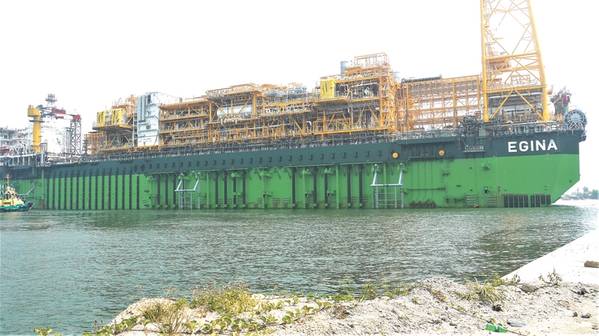
Access to and use of additive manufacturing (AM), also known as 3D printing, has increased in recent years due to the expiring of patents on techniques and technologies, says Hugues Greder, Lead Petroleum Engineer at Total.
Computing power is much more powerful and there’s also been an increase in the power of the lasers used in the AM process. While a large proportion of AM today is still for prototyping and tooling, about a third is for end uses, i.e. parts, he told the Underwater Technology Conference (UTC) in Bergen, Norway, earlier this year. And more is likely to come.
Total is keen to talk about AM after some recent success stories, including solving a problem during deepwater subsea pipeline commissioning that would have otherwise cost more than €10 million ($11.2 million) to rectify. The problem was found during the Egina field commissioning in 2018.
Discovered in 2003, the Egina field sits in 1,600 meters water depth, about 200 kilometers south of Port Harcourt, offshore Nigeria. Because it has a fairly shallow reservoir, at 1,400 meters below the mud-line, about 40-50 extended reach wells are being drilled on the field. These produce up to a 330-meter-long floating production, storage and offloading (FPSO) vessel – Total’s biggest – which came on stream last year, producing about 200,000 barrels of oil equivalent per day (boe/d), or about 10% of Nigerian production.
During commissioning, a problem arose. “When we wanted to connect the Egina gas export line to the Akpo gas export line, we couldn’t remove the pressure cap on the in-line tee assembly,” says Greder. “We tried several times and it didn’t work.” The pressure cap, sitting in 1,300 meters water depth, has a plunger flange and bolts. “When we looked, we saw traces of gas hydrates so we were thinking the blockage was due to gas hydrates inside.” Delay could have meant that the Egina FPSO was not commissioned on schedule.
The conventional way of dealing with this would be subsea intervention – and replacing the in-line tee. This would have cost in both time and money and would have meant shutting in Akpo. “A Nigerian colleague analyzed the situation and thought out of the box,” says Greder. “The idea was to remove the plunger and force methanol to the location.” The shape of a tool needed to do this was drawn up and then adapted with a view to using additive manufacturing to “print” it. AM meant the geometry could be more complex than if traditional manufacturing methods were used – and manufacturing time could be faster.
“We’re not constrained by tooling and you don’t need to have a solid part,” it can be hollow, which saves printing time and materials, Greder says. In fact, by printing it, the tool weight was reduced by 50%. The part, measuring 32 centimeters in diameter and 35 centimeters high, was printed in 36 hours, layer by layer, at Total group company Hutchinson (founded by an American businessman in France in 1853) in Paris. It was made using Polyamide 12 powder, which is laser sintered into the form required.
Using this method creates, initially, a large cube. With the non-sintered polyamide powder removed, the tool was revealed then shipped to Port Harcourt within 48-hours and then sent offshore. Using a remotely operated underwater vehicle (ROV), the plunger was unbolted and then the tool used to inject methanol, dissolving the hydrates in the pipe and successfully allowing the pressurized plug to be removed within four hours.
“It was 10 days from design to delivery, 50% lighter than expected, and the cost was reduced by a factor of 10 compared with a conventional subsea operation for this kind of problem, that would have cost more than €10 million,” says Greder. Akpo production also didn’t have to be halted and the gas export line was connected on schedule.
“Using additive printing means it’s topologically optimized. You can have shapes close to what nature can offer us, like a bee nest,” Greder says. By using this approach more, lead times, nonproductive time and production short-falls can be reduced. “In future, I can imagine a printer in Aberdeen, Stavanger, Bergen, where you can send a file and they print a tool you need and send it offshore. If you can do it on demand, you can also save storage cost.
“Another advantage is that compact sophisticated parts with more functions, lighter weight and easier to instrument, can be made,” he continues. “Tiny holes can be made to measure pressure at specific locations. These holes you cannot machine. But you can embed them precisely to allow you to do monitoring and pressure monitoring of a part. Third, you can do in-situ repairs to parts.”
Greder says that, for Total, this is something new and valuable in the field, and it’s happening more. “Several impellers have been made and put in refineries in France,” he says. “On the Culzean production facility in the UK North Sea, we 3D printed some titanium alloy inducers for installation on transfer pumps.” The modified impellors helped to counteract cavitation and could be produced quickly, instead of taking 24 weeks, using traditional methods.
“This will grow,” concludes Greder. “AM will certainly disrupt the oil and gas supply chain. More work needs to be done on quality of the material; you’re creating a part at the same time as creating the shape. Before, you were working on material that was created then the shape was certified. So there’s work to be done around certification of material and repeatability. There’s also intellectual property, if you want a copy of a part. For the time being, we have started using it on non-critical parts. But it will come.”